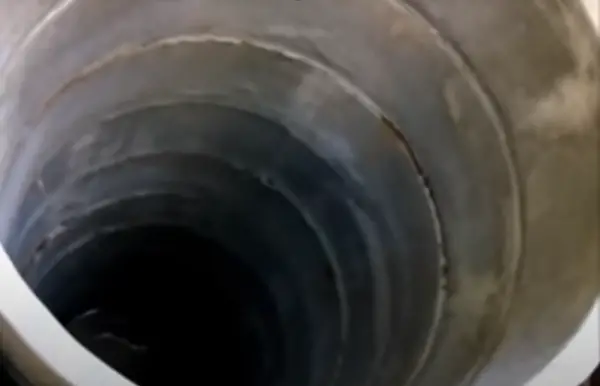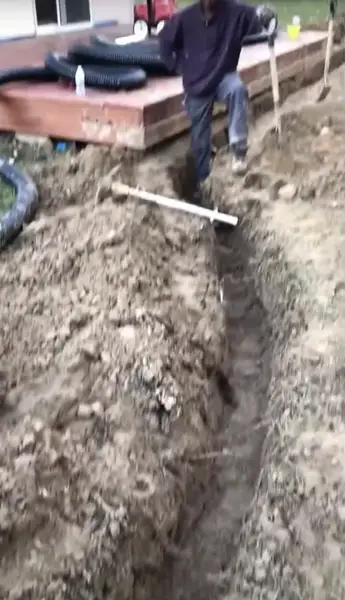In the simplest terms possible: If you can dig a hole in the yard and fill it with clean rocks, you have a dry well. If you can dig a trench in the yard and fill it with clean rock you have a French drain. However, there is more to it than that, which is why this guide is about selecting dry wells vs French drains.
The good news is that have a a French drain in the yard can keep the basement dry and prevent having to purchase a submersible sump pump for the basement.
Effective water management is crucial to maintaining a healthy and functional property. Whether you’re dealing with a soggy yard, a wet basement, or erosion problems, finding the right solution to manage excess water can save you time, money, and the headache of dealing with water-related issues.
In this guide, we’ll explore two common water management solutions: dry wells vs French drains. By understanding the principles, differences, and situational considerations associated with these solutions, you’ll be better equipped to make an informed choice.
Table of Contents
Understanding Dry Wells
Dry wells are underground structures designed to collect and store excess water, making them an invaluable tool for effective water management on your property. Let’s delve deeper into the key aspects of dry wells:

1. What Is A Dry Well and The Purpose of Dry Wells
Dry wells, also known as soakaways, are subsurface receptacles constructed to collect rainwater, stormwater runoff, or other surplus water from various sources, including roofs, driveways, or landscaping.
The primary purpose of dry wells is to prevent surface flooding, soil erosion, and water-related damage.
These structures are designed to provide a controlled and eco-friendly solution for handling excess water, ensuring that it is efficiently absorbed into the ground.
2. How Dry Wells Work to Manage Excess Water
Dry wells operate on a simple yet effective principle. They function as large underground containers or chambers that temporarily store incoming water. The key components of a typical dry well include an inlet, usually connected to a drainage system, and an outlet that connects to a system of perforated pipes or aggregate-filled chambers.
When water flows into the dry well, it is temporarily held, allowing the excess water to percolate into the surrounding soil gradually. This controlled release of water into the ground prevents rapid runoff and soil saturation.
Dry wells are particularly efficient at managing large volumes of water, especially during heavy rainfall or storms. By holding and gradually releasing water into the ground, dry wells help replenish groundwater sources, reduce the risk of surface flooding, and prevent soil erosion.
They are especially valuable in areas prone to waterlogging, where standing water can be a nuisance and a potential source of structural damage.
- COLLECT, DETAIN, AND INFILTRATE EXCESS WATER: Puts excess water back into the ground; the Flo-Well Dry Well is ideal for residential and commercial locations such as yards, playgrounds, golf courses, wash-down areas, rain gardens and bioswales
- HOW TO INSTALL: Connect to 4 in. Sewer and Drain (S&D) Pipe through top cover knockout; 12 side-panel knockout points connect to 4 in. S&D and Sch. 40 Pipes; Can be buried or stacked up to 8 ft. deep and supports pedestrian traffic including lawn tractors
- GRAVEL-FREE ALTERNATIVE: Unlike a traditional dry well that requires filling an large hole with heavy stone and gravel, the Flo-Well Dry Well only needs a small amount of gravel at the base to prevent scouring and provides 250% more detention volume
- USE ONE OR MANY: The Flo-Well Dry Well works as a stand alone product and can be used in multiples; units can be stacked up to 4 high or side-by-side 18 in. apart
- INCLUDES: 3 side panels and top cover, unassembled; open bottom allows water to seep into gravel and ground below; bottom panel sold separately to provide a base for a sump pump if desired
3. Situations Where Dry Wells Are a Viable Option
Dry wells are a suitable choice in several scenarios, making them a versatile solution for managing excess water:
- Keeping the basement dry: When rain water flows near the house foundation that water will naturally try to flow into the basement. Which is why many homes have a Zoeller M53 sump pump in the basement. However, a dry well placed in the yard can prevent a lot of water from running towards (and into) the basement.
● Urban and suburban areas: In developed areas with impervious surfaces like roofs, driveways, and sidewalks, dry wells can efficiently manage the runoff and prevent backyard flooding.
● Properties with limited space: Dry wells are compact and can be installed in small spaces, making them ideal for urban properties or places with limited yard space.
● Eco-friendly water management: For environmentally conscious property owners, dry wells offer the advantage of recharging groundwater by allowing water to seep into the soil. This not only helps manage water but also supports the local ecosystem.
● Mitigating erosion: In areas susceptible to erosion, dry wells can be strategically placed to reduce soil erosion and protect the landscape.
In summary, dry wells are an underground water management solution designed to collect, store, and gradually release excess water into the ground. Their adaptability and eco-friendly approach make them a practical choice for various situations, offering an effective way to mitigate drainage problems and protect your property from water-related issues.
The French Drain Solution
French drains are a time-tested and versatile solution for managing excess water, preventing water accumulation, and safeguarding your property from the adverse effects of water-related problems. In this section, we’ll explore the fundamental aspects of French drains:

1. Definition and Function of French Drains
A French drain is a drainage system designed to redirect water away from a particular area or structure. It typically consists of a trench filled with gravel or rock and a perforated pipe.
The primary function of a French drain is to provide a pathway for water to flow through the trench and into a designated drainage area, such as a storm sewer, dry well, or a lower-lying part of your property. This diversion of water prevents water accumulation, thus safeguarding your property from issues like flooding, erosion, and water damage.
2. The Mechanism Behind French Drains and How They Mitigate Water Problems
The key to the effectiveness of a French drain lies in its design and the principle of gravity. When excess water encounters the trench, it infiltrates the loose gravel or rock and enters the perforated pipe. Gravity then takes over, causing the water to flow through the pipe and away from the problem area.
Here’s how a French drain mitigates water problems:
● Water Collection: Excess water from rainfall, surface runoff, or groundwater intrusion is collected in the trench. The gravel or rock provides a medium for water to infiltrate and reach the perforated pipe.
● Gravity-Driven Flow: Once inside the perforated pipe, gravity guides the water away from the trouble spot, preventing water buildup and potential damage. The pipe is installed with a slight slope that ensures water moves away efficiently.
● Discharge: The diverted water is channeled to an outlet or drainage area, such as a storm sewer, a dry well, or a designated low-lying part of your property. This enables the water to disperse safely and naturally, without causing harm to your property.
French drains are incredibly effective at managing surface water, intercepting subsurface water, and preventing issues like foundation flooding, yard inundation, and erosion. They work well in both residential and commercial settings and can be customized to suit various property sizes and layouts.
3. When and Where French Drains Are Most Effective
French drains are most effective in specific situations and locations:
● Yard Drainage: If your yard is prone to water pooling, a French drain can prevent soggy areas, making it more usable and aesthetically pleasing.
● Basement and Foundation Protection: Installing French drains around the foundation or basement of your home can prevent water from seeping in, reducing the risk of costly water damage.
● Hillside or Sloping Terrain: In areas with slopes, French drains can divert water away from erosion-prone zones and keep your landscape intact.
● Surface Runoff Management: French drains are ideal for managing surface runoff from roofs, driveways, and walkways, ensuring that water is redirected efficiently.
● Landscaping and Garden Beds: These drains can protect delicate plants and landscape features from excessive water, maintaining the beauty and health of your outdoor spaces.
In conclusion, French drains are an essential water management solution that effectively diverts water away from problem areas, preventing flooding, erosion, and structural damage. Their adaptability and ability to work in various scenarios make them a valuable tool for property owners seeking to address water-related issues and maintain a dry, secure environment.

Key Differences Between a Dry Wells vs French Drains
Both dry wells and French drains are effective water management solutions, but they have distinct differences in their design, installation, water collection methods, and maintenance requirements.
1. Design and Installation
Dry Wells:
● Design: Dry wells typically consist of an underground chamber or container designed to collect and store water. This chamber is connected to an inlet that receives water from a drainage system and an outlet that allows excess water to be gradually absorbed into the ground.
● Installation: Installing a dry well involves excavating a hole at the chosen location, placing the chamber or container in it, and connecting the inlet and outlet. The chamber is often filled with aggregate material, such as gravel, to facilitate water percolation. The installation process may vary depending on the type of dry well used, but it generally requires careful positioning and proper connections.
French Drains:
● Design: French drains consist of a trench filled with gravel or rock and a perforated pipe. The trench is typically sloped to direct water away from the problem area. This design allows for the collection and redirection of water.
● Installation: The installation of a French drain begins with digging a trench along the desired drainage path. The trench is then filled with gravel or rock. A perforated pipe is placed at the bottom of the trench, and the trench is covered with additional gravel or rock. Proper slope and positioning ensure efficient water flow. French drain installation is often more straightforward and requires fewer components compared to dry wells.
2. Water Collection
Dry Wells:
● Dry wells collect and store water underground. When excess water flows into the dry well, it is temporarily held within the chamber. This stored water gradually percolates into the surrounding soil, allowing for efficient groundwater recharge. Dry wells store water for later absorption into the ground.
French Drains:
● French drains are designed to channel water away from a specific area. They do not store water but rather provide a pathway for water to flow through the trench and into a designated drainage area, such as a storm sewer or a dry well. The primary function of a French drain is to prevent water buildup in the first place by facilitating its redirection.
3. Maintenance
Dry Wells:
● Dry wells don’t usually need any maintenance. Over time, debris, silt, or sediment can accumulate within the chamber, potentially obstructing the water’s path. That could take quite a few years and would only reduce the amount of water that can enter the dry well during a rainstorm.
French Drains:
● French drains generally require very little maintenance. The most common maintenance task involves inspecting the perforated pipe for clogs or blockages caused by debris. Wrapping the French drain trench with a landscape cloth will keep dirt from entering the drain pipe.
In summary, while dry wells and French drains are valuable water management solutions, their key differences lie in design, installation, water collection methods, and maintenance requirements. The choice between dry wells vs French drains solutions should be based on your specific drainage needs and property characteristics. Understanding these distinctions will help you make an informed decision regarding the most suitable option for your situation.
- 【High Quality】4 in by 10 ft flexible expandable infiltration french drain pipe. Set water absorption, permeable and drainage as a whole. It seeps surface water into the ground and stores it. Set up your yard water circulation system
- 【Non-woven filter layer】Our french drain pipe has two layers of non-woven fabric which makes sure effective filtration and prevent sediment from entering the pipe. Able to be permeable omni-directionally to ensure nice permeability.Equivalent to gravel drainage system which comprise perforated pipe, gravel and non-woven fabric.
- 【Steel Wire Reinforced】The Soft Permeable Landscaping Drain Pipe is reinforced by steel wires to keep strong tensile and pressure strength. Sturdy enough to cover soil or gravel. Please mark the installation route. No livestock or vehicles allowed
- 【Economical Choice】No gravel and non-woven fabric need to build traditional gravel systems. This french drain kit saves your time and money. Help to set up your french drain system for yard.
- 【Multiple Applications】This outdoor french drain pipe 4 inch applies to various scenarios such as yard, backyard, lawn, garden, fence, landscape, patio, sidewalk, commercial zone, industrial area and so on.
Conclusions On Dry Wells vs French Drains
A dry well may solve your yard drainage problem all by itself. However, it is quite common that a French drain is used in combination with a dry well. Less often is there a need to use a submersible sump pump at the end of a French drain to pump water uphill. If you need a sump pump for outdoors or indoors, I recommend the Zoeller M53 sump pump.
In choosing between dry wells vs French drains, understanding the specific issues on your property is paramount. Both solutions offer effective ways to manage water, but their suitability depends on the unique circumstances of your situation.
Making an informed decision dry wells vs French drains ensures you’ll enjoy a dry and problem-free property while preserving the environment and complying with local regulations. Take the time to assess your needs, and you’ll be well on your way to a water-managed and worry-free property.

Author at Best Sump Pumps
The first time I helped to install a drain tile and basement sump pump system was 1978.
Since then I have worked for a city water utility where I worked with and maintained pumps.
My rental properties and personal homes all needed sump pumps.
As a modular home dealer/builder, those new homes needed sump pumps.
I put that experience to good use by providing reliable, useful, and practical advice on buying, using, and maintaining sump pumps.



